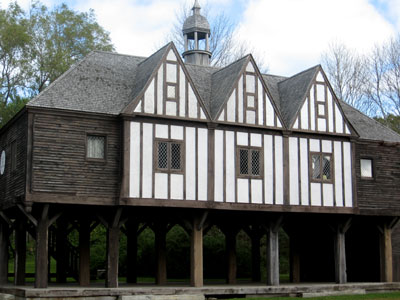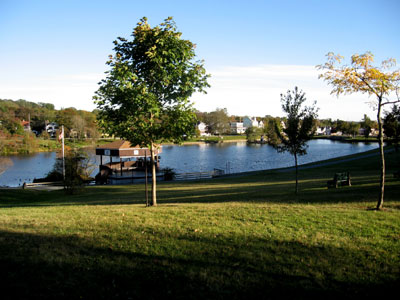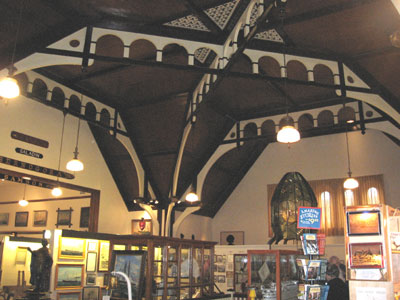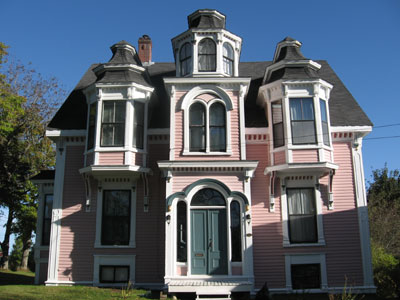My drive continued inland towards Shelburne, my next destination. Shelburne was first settled in the spring of 1783 when 5000 settlers, United Empire Loyalists, arrived here from the middle colonies in America. By 1784, the town was the fourth largest in all of North America, larger than Halifax, Montreal or Quebec City. Fishing, shipbuilding and the lumber industry formed the economic mainstays of the area. Many descendants of these Loyalists still live in the area today.
Black Loyalists also settled in this area when the Royal Governor of Virginia awarded freedom to any slave who would escape from a rebel slave master and fight alongside the British Loyalists. More than 300 Blacks joined the Loyalist forces and formed the Ethiopian Regiment. In total about 100,000 slaves took refuge behind British lines.

The public well on Ann Street in Shelburne
In 1782 when Americans were winning the war, the British prepared to depart. During this time some Blacks were recaptured while others resettled in Florida, the West Indies and Canada (or rather British North America, as it was called at the time). The largest group of Black settlers, about 3500 people, were transported to Nova Scotia and New Brunswick. Birchtown, just a few kilometers west of Shelburne, became the largest settlement of free Blacks outside of Africa. However, of 649 families only 184 received the promised crown land grants.

On the right: the George A. Cox Warehouse, on the left the Dory Shop
The Black Loyalist Heritage Society Museum in Birchtown commemorates the Black Loyalist settlers who founded the largest free Black settlement in all of North America. Unfortunately the museum was closed when I travelled through the area. However, I did have a chance to explore some of the Shelburne area’s other museums. This small town has a large museum complex on the waterfront which forms one of the best natural harbours in the world. I drove down on Main Street which features Victorian architecture as well as a large Romanesque Revival building constructed in 1908 from local granite which used to be the Post Office and Customs House. Coming down Ann Street I noticed a well that was located right in the middle of the road, an example of the community wells that were typical in this area.
Then I headed down to Dock Street on the Waterfront, formerly the centre of Shelburne’s commercial activity. I was immediately struck by a large wooden structure, dating back to 1902 which used to be the store and warehouse of George A. Cox, a prominent merchant who built his own vessels. Tucked in behind it is Guild Hall, a set from the move “A Scarlett Letter”. This building was constructed to reflect 17th century architecture.

Guild Hall, constructed for the movie “A Scarlett Letter”
Along the waterfront is the John C. Williams Dory Shop, a working museum that demonstrates the craft of dory building. Dories were small wooden fishing boats that were very popular in the around the turn of the 20th century and were purchased by Nova Scotian and American fishing captains. This shop dates back to 1880, and in its heyday five to seven men produced 350 dories a year.

Historical interpreters in the Ross-Thomson House
On the other side of the street is the restored Ross-Thomson House and Store. George and Robert Ross were merchants, trading pine boards, codfish and pickled herrings for salt, tobacco, molasses and dry goods. The store actually closed in the 1880s, was restored to its 1820s condition and today operates as a museum. I took a quick tour through the Ross-Thomson House which provides a good idea of the living conditions of the early Loyalist settlers.

Fashions of long ago in the Shelburne County Museum
Right in this complex is the Shelburne County Museum which houses one of the oldest fire pumpers in all of North America. It also features exhibits on shipbuilding and local Loyalist history. History buffs can access newspapers and court records from the 18th to the 20th century, all saved on microfilm, and genealogy records of Shelburne County families are also available.
Shelburne is a very scenic town with numerous unusual heritage buildings located on the waterfront and on various other streets leading up from the water. I wish I had had a bit more time to explore this town, but my schedule was getting tight. I wanted to continue on eastwards along the Lighthouse Trail to make sure I arrived before sunset so I would be able to see the town of Lunenburg before dark, one of Nova Scotia’s favourite destinations.




